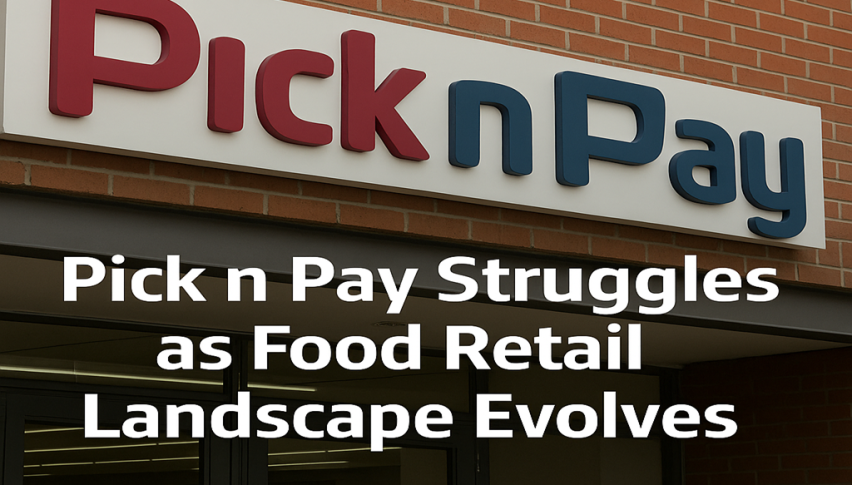South Africa’s Cost Crisis Hits Pick n Pay but JSE: PIK Share Price Finds Support – Bounce?
South Africa’s retail giant Pick n Pay is grappling with deep losses and shifting consumer habits as the country’s cost-of-living crisis bit

Quick overview
- Pick n Pay is facing significant losses and declining share prices amid South Africa's cost-of-living crisis.
- Despite the JSE All Share Index reaching a record high, major food retailers like Pick n Pay have seen share price declines of 10% to 25%.
- The rise in food prices and increased competition from informal retailers are major factors impacting consumer behavior and sales.
- While Pick n Pay's losses have narrowed, the retail sector continues to struggle with economic challenges and changing consumer preferences.
South Africa’s retail giant Pick n Pay is grappling with deep losses and shifting consumer habits as the country’s cost-of-living crisis bites.
JSE Hits Record High Despite Weak GDP
South Africa’s stock market may be setting records, but the country’s biggest grocery chains like Pick n Pay are wrestling with falling share prices and structural headwinds. Even with economic growth crawling at just 0.1% in the first quarter of 2025, South Africa’s JSE All Share Index has defied expectations by reaching an all-time high of 97,000 points. Investors have celebrated the market’s overall resilience, but this headline strength masks deep problems for some key consumer-facing sectors.
Major Food Retailers See Sharp Declines
While the broader index climbs, South Africa’s largest food retailers have suffered steep share price losses in the first half of the year. Shoprite, Woolworths, Pick n Pay, and SPAR have all seen share price declines of 10% to 25%, reflecting a tough operating environment and changing consumer behavior.
PIKJ Chart Monthly – The 20 SMA Holding Is A Positive Signal
Pick n Pay’s struggles are particularly severe. Since peaking around 8,300 ZAC in 2018, its share price has been in a prolonged slide. After plunging to 1,855 ZAC—an ~80% decline—by 2022, the stock saw a modest bounce in 2024. But fresh losses reported in 2025 have reignited selling pressure. Technical charts show the price clinging to support near the 20 SMA (gray) on the monthly timeframe, but momentum remains weak, raising fears of another downward leg if buying doesn’t return soon.
The Cost-of-Living Squeeze
A core driver of these declines is the dramatic rise in food prices. Over the past three to four years, retail food costs have reportedly climbed 30% to 300%—far beyond official inflation figures. That increase has put huge pressure on the consumer base, particularly among lower-income households, forcing shoppers to rethink where they buy essentials.
This environment has hurt traditional big-box retailers. Shoppers seeking cheaper alternatives have shifted away from major chains like Pick n Pay, whose high-store costs make price competition challenging.
Structural Shifts in South African Retail
Each retailer has offered its own explanation for the decline—from challenging high bases to specific losses in recent reporting periods. But a shared theme is clear: South African retail is undergoing a structural shift.
Pick n Pay’s latest annual report paints a stark picture. It cites low economic growth, high unemployment, inflationary pressure, and persistent infrastructure problems as headwinds. Most importantly, it highlights that consumers have become far more price-sensitive, demanding better value, cheaper pricing, and convenience.
Informal Sector Growth and Competitive Pressures
Another major challenge is the rapid rise of the informal economy. Spaza shops—small, locally run convenience stores—are thriving, offering lower prices, closer proximity, and better value. These stores have become increasingly popular, especially in township and peri-urban areas, drawing customers away from formal retailers.
Pick n Pay itself warned in its results that this shift is a competitive threat. In a retail market where margins are thin and volumes matter, losing share to the informal sector can be devastating.
Pick n Pay’s Loss Narrows but Challenges Remain
Despite the grim backdrop, there are faint signs of progress. For the fiscal year ending March 2, 2025, Pick n Pay recorded an attributable net loss of R736 million (~$20 million). While still negative, this is a sharp improvement on the R3.3 billion loss the year before. Headline losses have declined by over 60%, suggesting that tough restructuring measures are starting to pay off.
Nonetheless, the overall picture remains challenging. The retail industry in South Africa is at a crossroads, grappling with a shifting consumer base, soaring living costs, and a rapidly evolving competitive landscape. Whether the country’s largest food chains can adapt—and regain investor confidence—will be one of the key stories to watch in the coming months.
- Check out our free forex signals
- Follow the top economic events on FX Leaders economic calendar
- Trade better, discover more Forex Trading Strategies
- Open a FREE Trading Account



